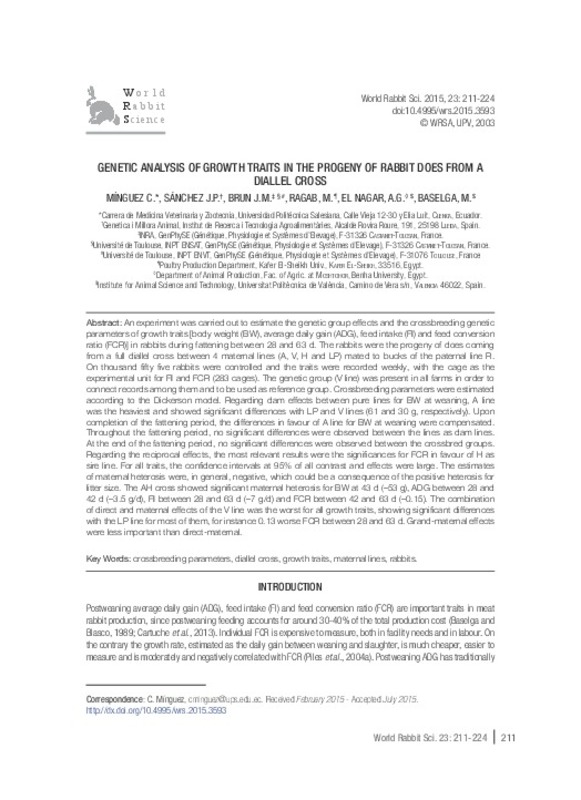JavaScript is disabled for your browser. Some features of this site may not work without it.
Buscar en RiuNet
Listar
Mi cuenta
Estadísticas
Ayuda RiuNet
Admin. UPV
Genetic analysis of growth traits in the progeny of rabbit does from a diallel cross
Mostrar el registro sencillo del ítem
Ficheros en el ítem
| dc.contributor.author | Mínguez, C.
|
es_ES |
| dc.contributor.author | Sánchez, J.P.
|
es_ES |
| dc.contributor.author | Brun, J.M.
|
es_ES |
| dc.contributor.author | Ragab, M.
|
es_ES |
| dc.contributor.author | El Nagar, A.G.
|
es_ES |
| dc.contributor.author | Baselga, M.
|
es_ES |
| dc.date.accessioned | 2016-06-24T11:19:40Z | |
| dc.date.available | 2016-06-24T11:19:40Z | |
| dc.date.issued | 2015-12-23 | |
| dc.identifier.issn | 1257-5011 | |
| dc.identifier.uri | http://hdl.handle.net/10251/66431 | |
| dc.description.abstract | [EN] An experiment was carried out to estimate the genetic group effects and the crossbreeding genetic parameters of growth traits [body weight (BW), average daily gain (ADG), feed intake (FI) and feed conversion ratio (FCR)] in rabbits during fattening between 28 and 63 d. The rabbits were the progeny of does coming from a full diallel cross between 4 maternal lines (A, V, H and LP) mated to bucks of the paternal line R. On thousand fifty five rabbits were controlled and the traits were recorded weekly, with the cage as the experimental unit for FI and FCR (283 cages). The genetic group (V line) was present in all farms in order to connect records among them and to be used as reference group. Crossbreeding parameters were estimated according to the Dickerson model. Regarding dam effects between pure lines for BW at weaning, A line was the heaviest and showed significant differences with LP and V lines (61 and 30 g, respectively). Upon completion of the fattening period, the differences in favour of A line for BW at weaning were compensated. Throughout the fattening period, no significant differences were observed between the lines as dam lines. At the end of the fattening period, no significant differences were observed between the crossbred groups. Regarding the reciprocal effects, the most relevant results were the significances for FCR in favour of H as sire line. For all traits, the confidence intervals at 95% of all contrast and effects were large. The estimates of maternal heterosis were, in general, negative, which could be a consequence of the positive heterosis for litter size. The AH cross showed significant maternal heterosis for BW at 43 d (–53 g), ADG between 28 and 42 d (–3.5 g/d), FI between 28 and 63 d (–7 g/d) and FCR between 42 and 63 d (–0.15). The combination of direct and maternal effects of the V line was the worst for all growth traits, showing significant differences with the LP line for most of them, for instance 0.13 worse FCR between 28 and 63 d. Grand-maternal effects were less important than direct-maternal. | es_ES |
| dc.description.sponsorship | This work was supported by the Spanish project AGL2011-30170- C02-01 from the Spanish National Research Plan. C. Minguez acknowledges a Formacion de Personal Investigador (FPI) grant from the Ministerio de Economia y Competitividad (MEC), Spain. | en_EN |
| dc.language | Inglés | es_ES |
| dc.publisher | Editorial Universitat Politècnica de València | |
| dc.relation.ispartof | World Rabbit Science | |
| dc.rights | Reserva de todos los derechos | es_ES |
| dc.subject | rossbreeding parameters | es_ES |
| dc.subject | diallel cross | es_ES |
| dc.subject | Growth traits | es_ES |
| dc.subject | Maternal lines | es_ES |
| dc.subject | Rabbits | es_ES |
| dc.title | Genetic analysis of growth traits in the progeny of rabbit does from a diallel cross | es_ES |
| dc.type | Artículo | es_ES |
| dc.date.updated | 2016-06-24T10:53:23Z | |
| dc.identifier.doi | 10.4995/wrs.2015.3593 | |
| dc.relation.projectID | info:eu-repo/grantAgreement/MICINN//AGL2011-30170-C02-01/ES/DIVERSIDAD GENETICA EN EL CONEJO DE CARNE. INTERACCIONES CON REPRODUCCION, CRECIMIENTO Y SALUD DIGESTIVA/ | es_ES |
| dc.rights.accessRights | Abierto | es_ES |
| dc.description.bibliographicCitation | Mínguez, C.; Sánchez, J.; Brun, J.; Ragab, M.; El Nagar, A.; Baselga, M. (2015). Genetic analysis of growth traits in the progeny of rabbit does from a diallel cross. World Rabbit Science. 23(4):211-224. https://doi.org/10.4995/wrs.2015.3593 | es_ES |
| dc.description.accrualMethod | SWORD | es_ES |
| dc.relation.publisherversion | https://doi.org/10.4995/wrs.2015.3593 | es_ES |
| dc.description.upvformatpinicio | 211 | es_ES |
| dc.description.upvformatpfin | 224 | es_ES |
| dc.type.version | info:eu-repo/semantics/publishedVersion | es_ES |
| dc.description.volume | 23 | |
| dc.description.issue | 4 | |
| dc.identifier.eissn | 1989-8886 | |
| dc.contributor.funder | Ministerio de Ciencia e Innovación |








